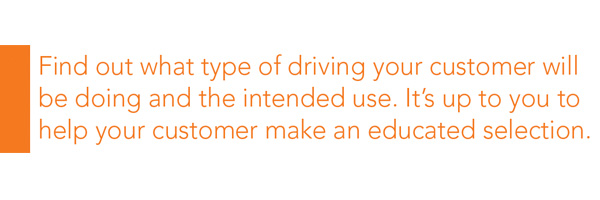
Brake pads come in many shapes and sizes, as well as compounds. It’s all a compromise that the OEMs make on the conservative side for safety and reliability. Not all vehicle owners are exactly alike in the way they drive or what kind of performance they want from their brakes. City driving is hard on components and typically generates more heat in brake pads. Highway driving isn’t as severe, but you also want to be able to stop at a moment’s notice if necessary.
In severe-duty driving, brake pads wear out quickly, as the vehicle often is in stop-and-go traffic situations. Eventually, the pads wear out, but your customer may not always notice the telltale signs until metal touches metal.
Most brake-pad manufacturers recommend changing the pads when they wear down to between 2 and 4 millimeters thick. In most cases, the brake-pad wear sensor (a metal clip) reaches the minimum thickness and touches the rotor. The resulting sound from the sensor touching the metal rotor is a squealing noise that should alert the driver that there’s only about 25 percent of the life left. In some cases, on late-model vehicles, this will trigger an electronic sensor that will display a warning light on the dashboard.
Brake pads are available in a few different compounds for typical passenger-car driving. Counter pros should be familiar with the available brands and materials that they’re made from to better recommend a set that’s right for your customer. Some customers may wish to upgrade the performance of the brakes with a more aggressive pad lining and rotors.
Three Types of Brake Pads
There are three basic brake-pad styles.
Non-asbestos organic (NAO) pads are made from natural compounds such as glass, rubber, carbon and copper (a little), among other proprietary materials that go into making the resin for the linings. These are typically the least expensive and are OE-fit for many entry-level compact vehicles.
Semi-metallic pads are a popular choice for aftermarket linings because they offer improved stopping performance over stock OE pads, in most cases. Semi-metallic pads have high metallic content, up to 60 percent or more chopped steel wool fiber. Semi-metallic pads offer better stopping power because they use a more abrasive material, but they tend to be noisy, which some customers won’t like.

Ceramic pads currently ARE the top choice for stock, daily driven vehicles and come standard in many higher-end, luxury late-model vehicles. There are several benefits to using ceramic pads, but they’re not meant for heavy-duty or high-performance braking applications. If your customer plans to run track days or tow a boat, a semi-metallic pad is a better option. That said, ceramic material is quieter and lasts longer, plus it doesn’t create as much dust on the wheels, which many car enthusiasts with premium wheels may prefer.
Find out what type of driving your customer will be doing and the intended use. It’s up to you to help your customer make an educated selection. And remember: Braking is always a compromise.











